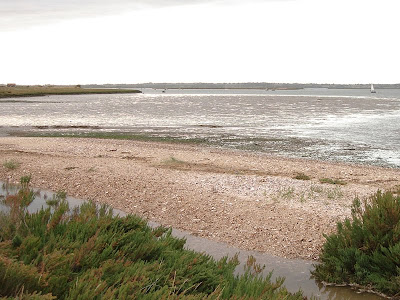 More sunshine at the country park on Thursday 24th was ideal for the butterflies and this small copper was one of 3 seen flying low amongst the grass. The most colourful butterfly seen was a brightly marked clouded yellow, which crossed the park and passed right in front of me as it headed down onto the beach. This is only the second sighting this summer on the park although there have been 3 other sightings along the north side of the Island. Other butterflies seen today were speckled wood, large white, small white and red admiral. One ivy clump in flower to the north of the park was alive with insects on Tuesday including 2 painted ladies, 2 red admirals and a comma.
More sunshine at the country park on Thursday 24th was ideal for the butterflies and this small copper was one of 3 seen flying low amongst the grass. The most colourful butterfly seen was a brightly marked clouded yellow, which crossed the park and passed right in front of me as it headed down onto the beach. This is only the second sighting this summer on the park although there have been 3 other sightings along the north side of the Island. Other butterflies seen today were speckled wood, large white, small white and red admiral. One ivy clump in flower to the north of the park was alive with insects on Tuesday including 2 painted ladies, 2 red admirals and a comma. Lots of house martins have been passing over the park again today with 50 seen although not quite as many as the day before when 200 flew over. A few meadow pipits also flew over as did 3 skylarks.
Lots of house martins have been passing over the park again today with 50 seen although not quite as many as the day before when 200 flew over. A few meadow pipits also flew over as did 3 skylarks. Having to make a rare visit to the rear of the park grazing fields was so unusual that 2 foxes were caught napping in the long grass. They jumped into this ditch to make their escape and sprinted off across the grass field in different directions. A snipe was also flushed from the muddy edge of this ditch.
Having to make a rare visit to the rear of the park grazing fields was so unusual that 2 foxes were caught napping in the long grass. They jumped into this ditch to make their escape and sprinted off across the grass field in different directions. A snipe was also flushed from the muddy edge of this ditch.A reed warbler was seen in some reeds at the back of the fields and elsewhere a few linnets and goldfinches were seen. On the re-flooded pools 30 teal loafed or fed in the shallow waters as did 25 moorhens. Around the park a whitethroat and 4 chiffchaffs were seen or heard from various corners.
Earlier in the morning the flock of linnets at Bocking Hall farm were gathered on some overhead wires with about 200 birds present.
Driving along Bromans Lane from the park late on Thursday evening, two badgers were seen jogging along the road in the car headlights.
 An early evening check of the waders on Wednesday 23rd, on the beach as the tide was on its way out from the country park, provided views of about 70 curlew, some pictured above. Also seen were one sanderling, 50 ringed plover, 100 golden plover, 20 grey plover, 50 oystercatcher, 100 redshank and 70 turnstones, on the newly exposed mud. Offshore were a couple of common terns seen flying past but little else.
An early evening check of the waders on Wednesday 23rd, on the beach as the tide was on its way out from the country park, provided views of about 70 curlew, some pictured above. Also seen were one sanderling, 50 ringed plover, 100 golden plover, 20 grey plover, 50 oystercatcher, 100 redshank and 70 turnstones, on the newly exposed mud. Offshore were a couple of common terns seen flying past but little else.Earlier in the day 15 little egrets were seen feeding along the water's edge as the tide came in.
 The Gunfleet Sands windfarm is slowly becoming operational with just under half of the planned 48 turbines installed so far. This digiscoped view above from the park is looking over towards Colne Point and out at sea beyond Clacton and Jaywick. Visibility this evening wasn't quite so clear to get good views of the wind-farm offshore from north Kent.
The Gunfleet Sands windfarm is slowly becoming operational with just under half of the planned 48 turbines installed so far. This digiscoped view above from the park is looking over towards Colne Point and out at sea beyond Clacton and Jaywick. Visibility this evening wasn't quite so clear to get good views of the wind-farm offshore from north Kent.At dusk 2 badgers were seen jogging down the small field past the pond, disppearing into the hedgerow. The water vole was seen in the same place at the pond feeding on some reedmace stems. Two little owls called to each other at dusk.




























